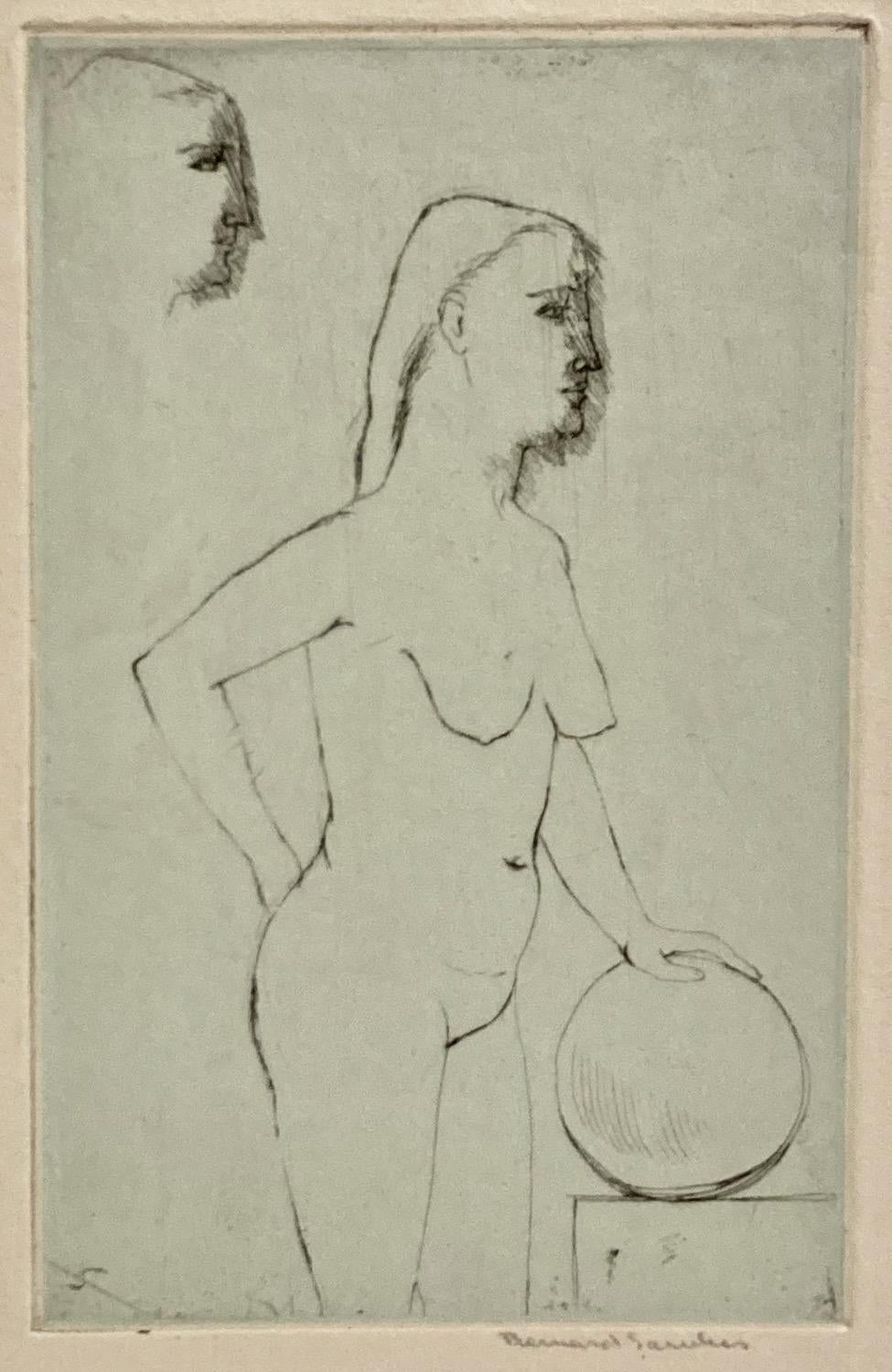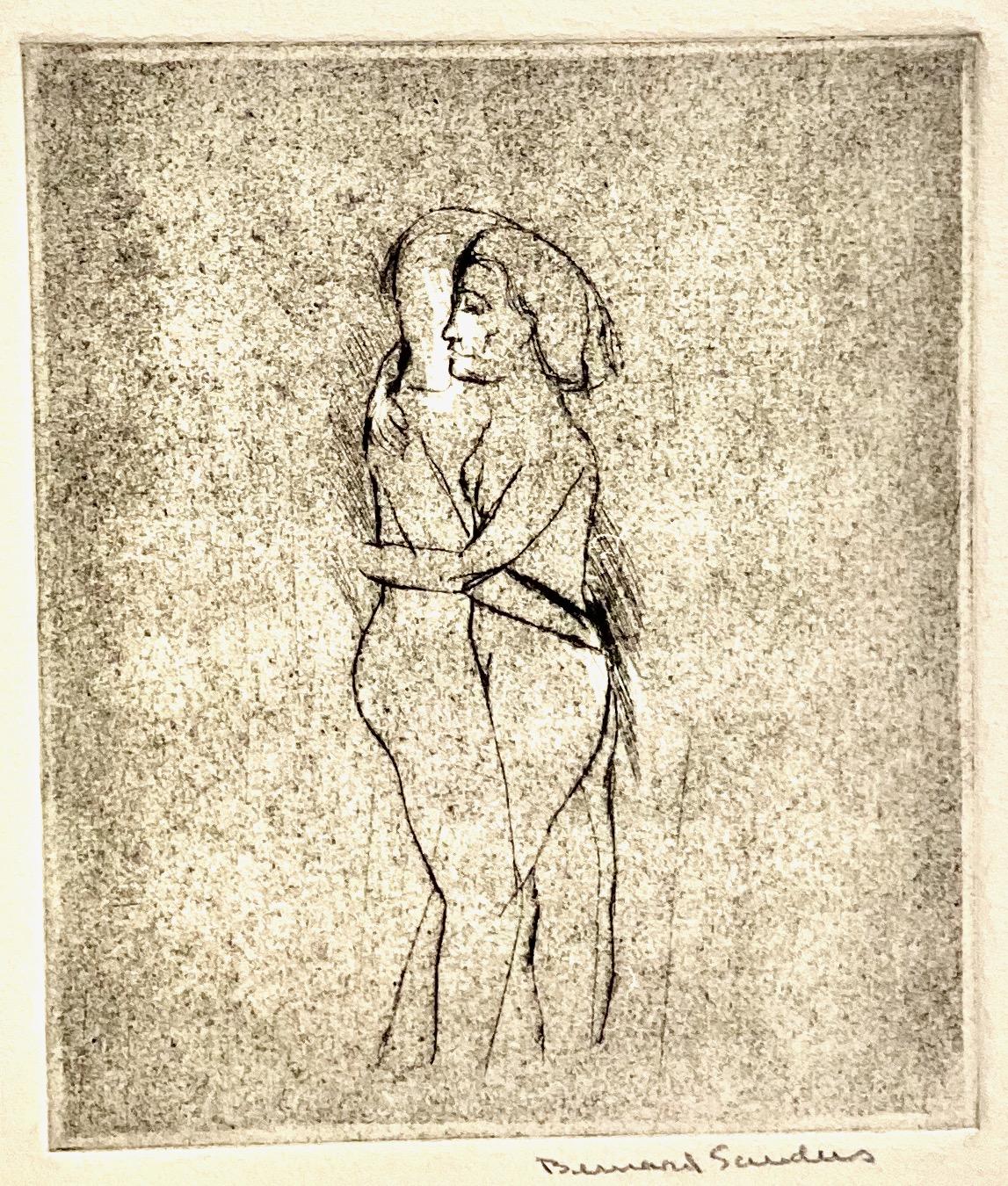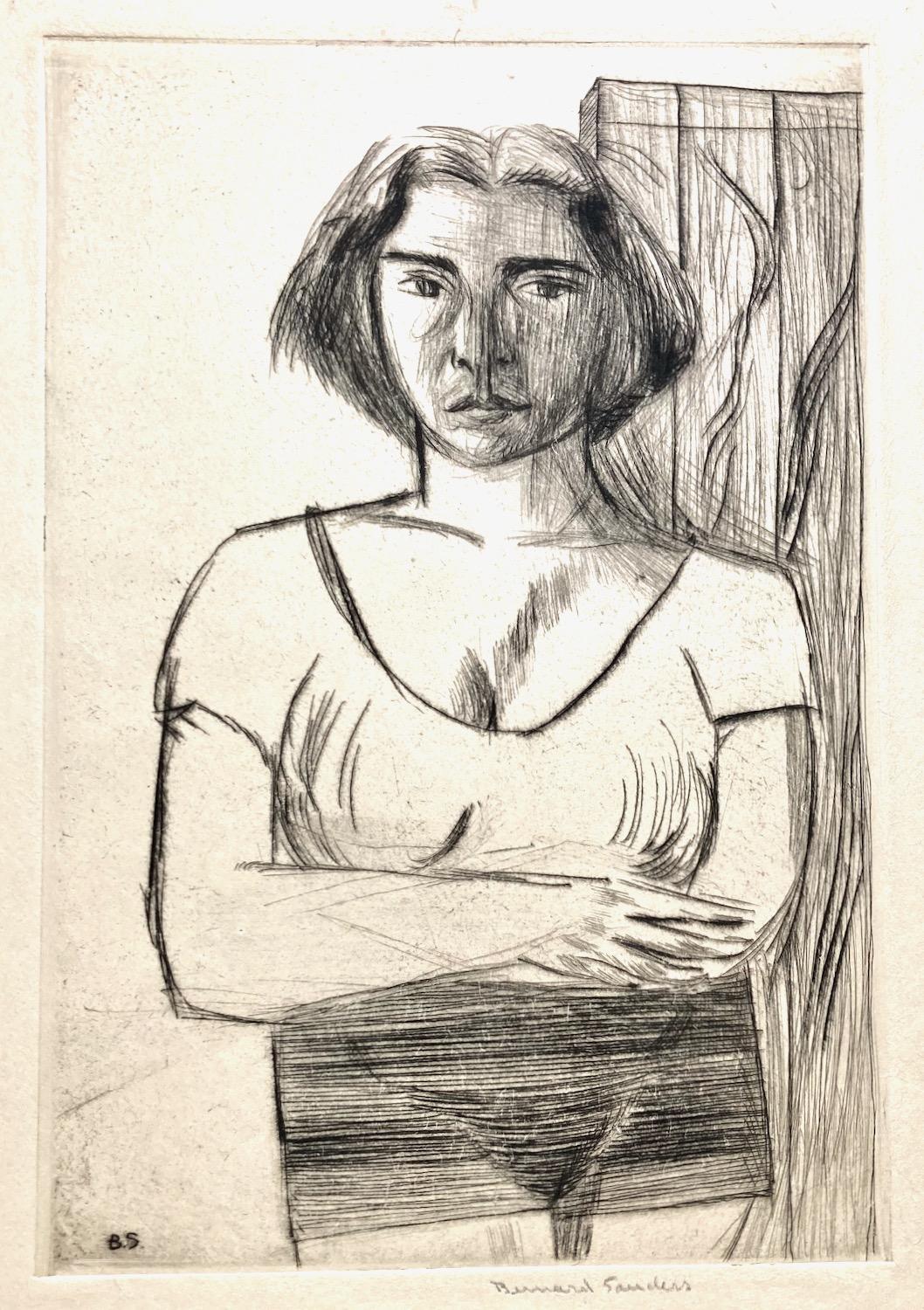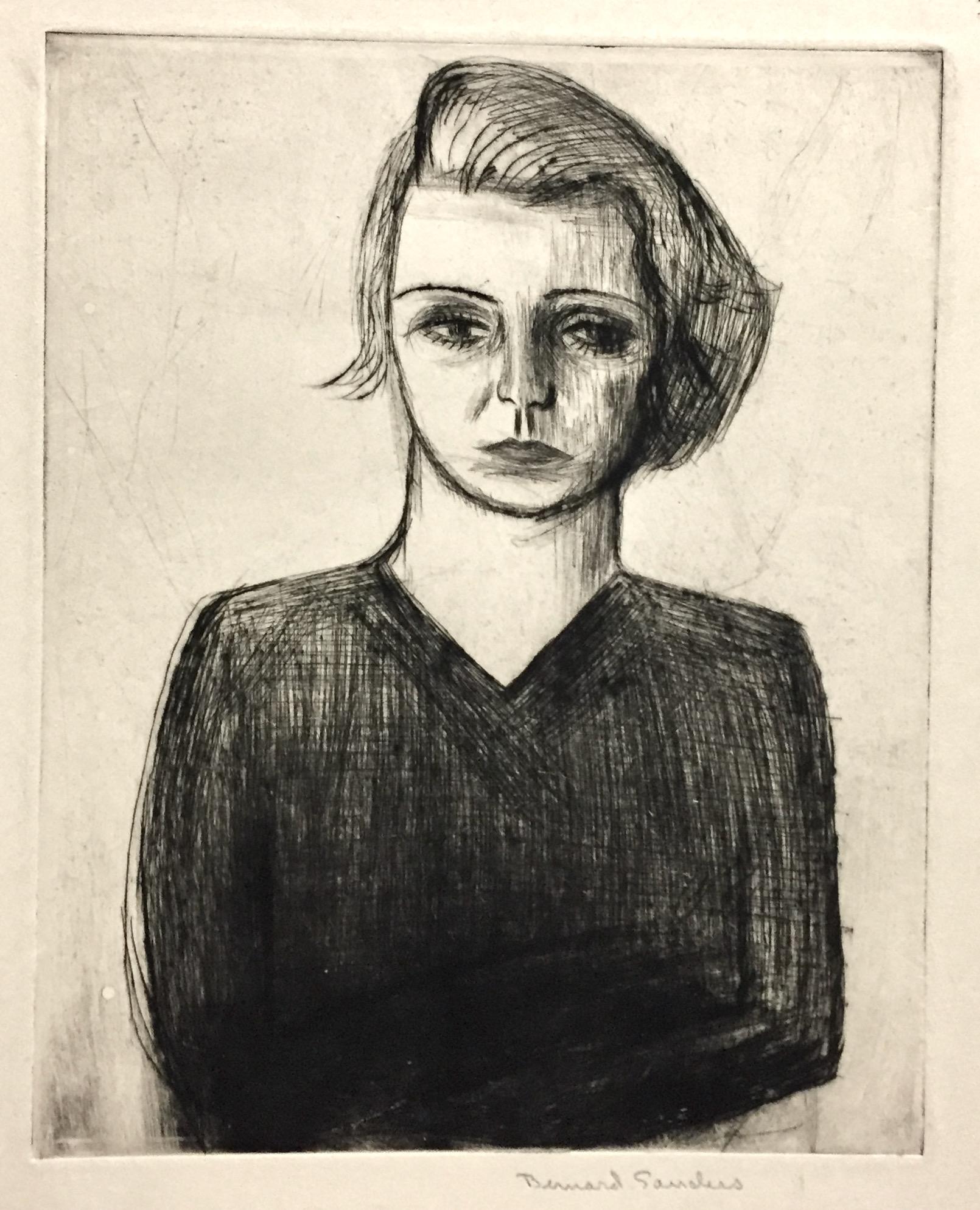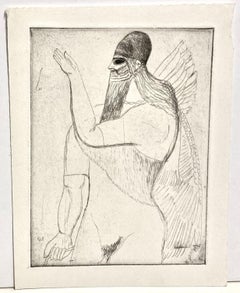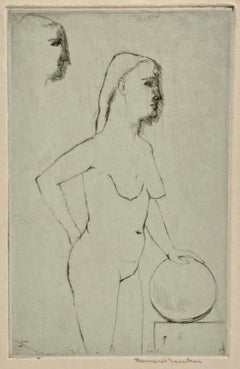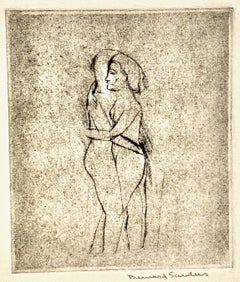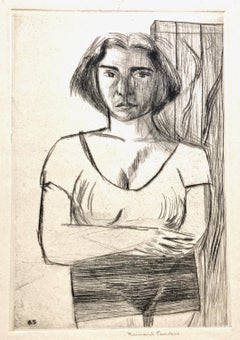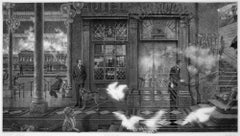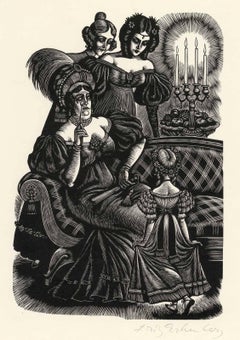Items Similar to Bernard Sanders, (Two Young Girls), about 1925
Want more images or videos?
Request additional images or videos from the seller
1 of 7
Bernard SandersBernard Sanders, (Two Young Girls), about 19251925
1925
About the Item
Bernard Sanders (1906-1967) was a master at suggesting layers of meaning. Here, at first glance, this is study of sisters, posed to show subtle differences in height and profile. But on closer inspection things get more serious. They are so still, anchored to their spots. Could this be part of Sanders' medical studies? Are these girls compromised in some way that's not immediately apparent. Something seems 'off' with them.
This is a drypoint. It is signed in pencil.
- Creator:Bernard Sanders (1906 - 1967)
- Creation Year:1925
- Dimensions:Height: 7.38 in (18.75 cm)Width: 6.07 in (15.42 cm)
- Medium:
- Movement & Style:
- Period:
- Condition:Good condition. The pin holes are from the drying process. There are traces of old tape (or hinges) in the upper corners and minor staining in the margins.. There's slight buckling in the image and traces of pink paper transfer on the reverse.
- Gallery Location:New York, NY
- Reference Number:1stDibs: LU1410214856302
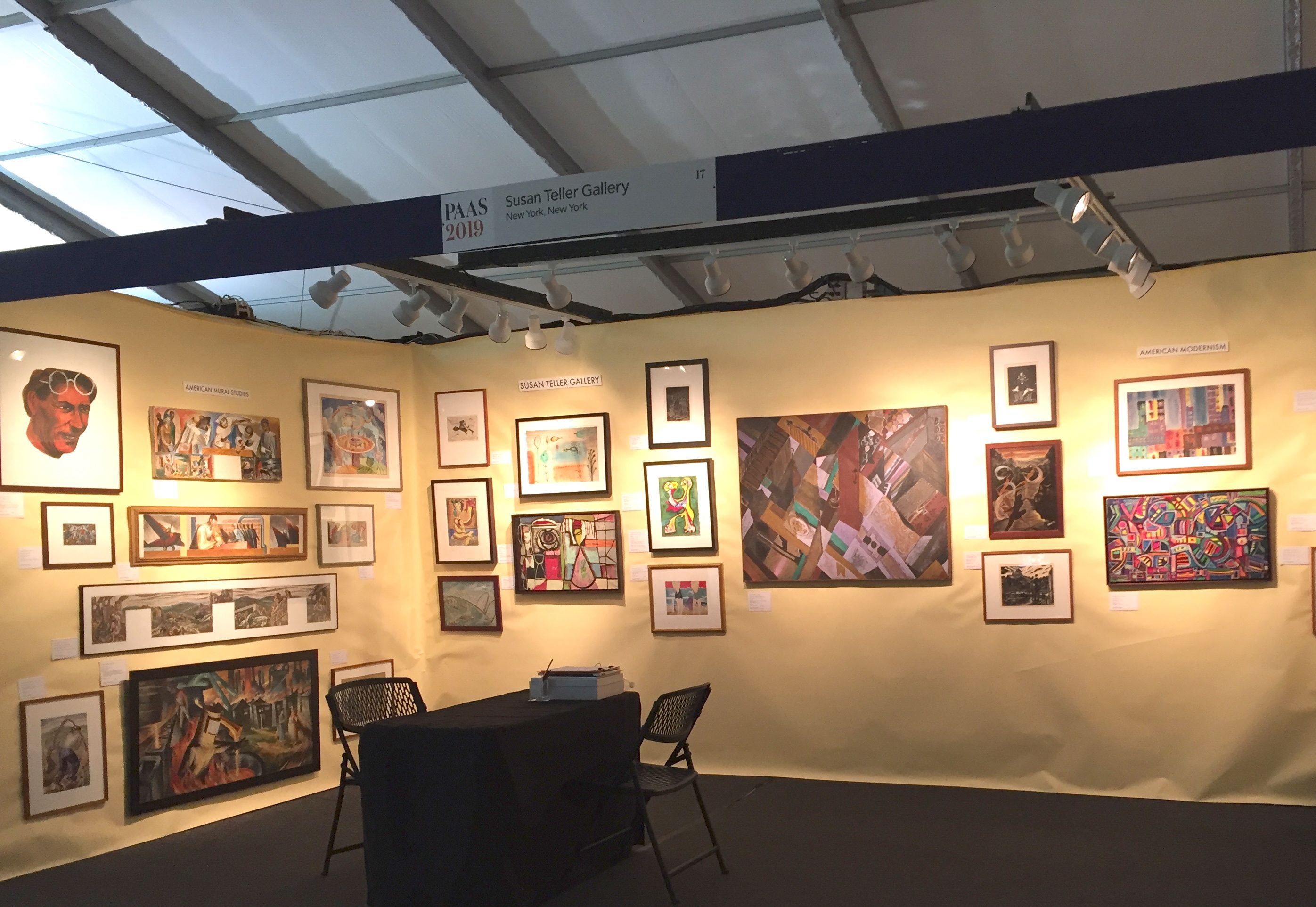
About the Seller
4.9
Platinum Seller
Premium sellers with a 4.7+ rating and 24-hour response times
Established in 1988
1stDibs seller since 2020
113 sales on 1stDibs
Typical response time: 1 hour
- ShippingRetrieving quote...Shipping from: New York, NY
- Return Policy
Authenticity Guarantee
In the unlikely event there’s an issue with an item’s authenticity, contact us within 1 year for a full refund. DetailsMoney-Back Guarantee
If your item is not as described, is damaged in transit, or does not arrive, contact us within 7 days for a full refund. Details24-Hour Cancellation
You have a 24-hour grace period in which to reconsider your purchase, with no questions asked.Vetted Professional Sellers
Our world-class sellers must adhere to strict standards for service and quality, maintaining the integrity of our listings.Price-Match Guarantee
If you find that a seller listed the same item for a lower price elsewhere, we’ll match it.Trusted Global Delivery
Our best-in-class carrier network provides specialized shipping options worldwide, including custom delivery.More From This Seller
View AllBernard Sanders, (Mesopotamian Figure)
Located in New York, NY
Clearly Sanders was looking at ancient Mesopotamian figures. Even the elaborate feathered wings can be found there -- made about 5000 years ago!
There's an initial 'S' in the plate...
Category
Early 20th Century American Modern Interior Prints
Materials
Drypoint, Etching
Bernard Sanders, (Nude Woman with Orb)
Located in New York, NY
Sander's figures are captivating. Here a women stands facing right, just touching, and holding still, a globe shape, on a flat surface.
It was difficult getting the color to show p...
Category
Early 20th Century American Modern Interior Prints
Materials
Drypoint, Etching
Bernard Sanders, (Lovers)
Located in New York, NY
Clearly Sanders (1906-1967) was a master at these minimalist figurative prints. It's all about atmosphere and tension.
Perhaps reflecting the print here, (Lovers), he, in fact, w...
Category
Early 20th Century American Modern Interior Prints
Materials
Drypoint, Etching
Bernard Sanders, Young Girl (With Arms Crossed), about 1930
Located in New York, NY
Young Girl by Bernard Sanders (1906-1967) is a classic example of his masterful portraiture.
This is a drypoint. It is signed in pencil, titled in the lower left margin, and initial...
Category
1930s American Modern Figurative Prints
Materials
Drypoint
Bernard Sanders, Head of Girl
Located in New York, NY
For a print that's nearly one hundred years old it feels very contemporary.
Signed in pencil; titled in lower margin in pencil.
Category
Early 20th Century American Modern Interior Prints
Materials
Drypoint
Bernard Sanders, (Interior with Five Men)
Located in New York, NY
The always fashionable Bernard sanders draws a mysterious spaces with well-dressed gentlemen. Signed in pencil.
Category
Early 20th Century American Modern Figurative Prints
Materials
Drypoint
You May Also Like
Interiors VII: The Train from Munich
By Peter Milton
Located in Middletown, NY
Interiors VII: The Train from Munich
Robert E. Townsend, 1991.
Resist ground etching and engraving with hand refinement in charcoal, pencil, stabilo, and eraser on BFK Rives white wove paper, 20 x 36 inches (507 x 914 mm), full margins. Signed, titled, dated and numbered 51/175 by the artist in pencil, lower margin. A brilliant, inky impression with luminous light and gradient tones. In excellent condition with one extremely minor and superficial spot of light tan adhesive residue on the verso, unobtrusive and not visible on the recto, with no other visible defects. With the blind stamp of the printer, Robert E. Townsend in the lower left margin. An especially fine impression in superb condition. [Milton 113].
When asked about this work in particular, Milton expressed that his favorite images were his darkest images, in theme, mood, and in ink. Milton, who has said that his work is infused with a postmodern awareness of the past, has focused here in a deeply personal way on a segment of history that continues to haunt us all. The work, published in 1991, evokes one of the darkest periods of European history, the eroding and erasing of European culture under fascism, and the eventual total loss of humanity. The Train from Munich is an especially relevant and emotional work for Milton, who created the piece for his wife, Edith, who escaped Munich in 1939 as a child on the fabled Kinderstransport. The Kinderstransport was a desperate rescue effort on the part of the British government to save as many Jewish children as possible by railway before borders closed on the precipice of the Second World War. Children left their parents behind, and boarded the trains alone, leaving the impending doom of Nazi Germany, they arrived in Great Britain as refugees. More than 10,000 children escaped the holocaust via the Kinderstransport. In Train from Munich, the image itself holds an almost immeasurable amount of symbolism; each inch of the matrix is a successful effort to confront this history in a way that is poignant through a series of motifs. We see the Café disappearing into a ghostlike memory of the past, an allegory to the disintegration of culture, while through the windows we can see a rampant, snarling dog; a portrait of Hitler's shepherd, Blondi. Blondi isn't the only notable figure in the composition. Milton has pointed out that the fading figure of the doorman at the Hotel Metropole is modeled after the artist and intellectual Marcel Duchamp, and the face of the young girl peering...
Category
1990s American Modern Interior Prints
Materials
Charcoal, ABS, Engraving, Etching
Adele and the Ladies (Rochester's fashion conscious ward in Jane Eyre)
By Fritz Eichenberg
Located in New Orleans, LA
Adele, the 10 year-old girl who may be the daughter of Rochester and Celine in "Jane Eyre" is being scrutinized by three women. One is seated on an ornate sofa...
Category
Early 20th Century American Modern Figurative Prints
Materials
Wool, Engraving
Interiors I: Family Reunion — A penetrating scene with a hidden homage to Eadwea
By Peter Milton
Located in Middletown, NY
Interiors I: Family Reunion
1984
Resist ground etching and engraving on BFK Rives wove paper, 20 x 36 inches (501 x 913 mm), full margins. Signed, titled, dated and numbered 49/175 in pencil, lower margin. In excellent condition with minor mat tone. A luminous, rich, and well-inked impression of this haunting image, with astonishing detail and depth. Framed handsomely under museum grade glass with archival materials in a solid wood frame with silver finish. [Milton 107]
Intended to be a stand alone image in its inception, Family Reunion ended up spawning seven additional images, and became a sort of Primo Pensiero in the sprawling, masterpiece suite now known as Interiors. The suite took eight years to complete, and consists of works of varying format, psychological intensity, and subject matter. The thematic darkness in the eight images waxes and wanes, and Milton intentionally included several interlude works to lighten the tension he felt while composing several of the darker images. The first two in the series, Family Reunion, and Hotel Paradise Café, were meant to be companion pieces. The equilibrium of each composition is anchored on a central brooding figure; a man (perhaps based on a Thomas Eakins portrait of the American anthropologist Frank Hamilton...
Category
1980s American Modern Figurative Prints
Materials
Engraving, Etching
Soup
By Edmund Blampied
Located in Storrs, CT
Soup. 1920. Drypoint. Appleby 65. 9 x 8 1/8 (sheet 15 x 11 9/16). Edition 100. Illlustrated: Print Collector's Quarterly 13 (1926): 85. Signed in pencil.
Edmund Blampied was a painter, etcher, lithographer and sculptor. Born in 1886 to a family of three boys in St. Martin, Jersey, Blampied became interested in drawing at an early age. After visiting the studio of John Helier Lander in 1899, Blampied decided to make a career as an artist. In 1903 he went to London to attend Lambeth Art School, where he studied etching under Walter Seymour.
In 1905, he joined the Daily Chronicle as an artist. In that year he was awarded a scholarship to Bolt Court Scool of Photo-engraving and Lithography.
In 1912 he left the Chronicle and established his own studio. He earned a living by illustrating novels and short stories.
In 1913, he had his first exhibition at the Leicester Gallery in London. The following year he married Marianne Van Abbé.
During the 1920's, he became a member of the Royal Society of Painter-Etchers and Engravers. During the 1920s Blampied became a member of the Royal Society of Painters-Etchers and Engravers and exhibited in London to critical acclaim. He produced a folio of comic drawings in the 1930s which was published in New York in 1934 and another that was published in London in 1936. The Keeper of Prints and Drawings at the British Museum published a mongraph on his work. His London exhibitions were highly successful.
In 1938, he moved to Bulwarks, St.Aubin in Jersey, but at the onset of the Occupation, had to relocate to Route Orange, St. Brelade. remained there throughout World War II during the German Occupation, despite the fact that his wife was Jewish. During the Occupation he designed bank...
Category
1920s Modern Figurative Prints
Materials
Drypoint, Etching
Vin Rouge (Red Wine)
By Edmund Blampied
Located in Storrs, CT
1932. Drypoint. Appleby 167. 9 1/4 x 11 5/8 (sheet 11 3/8 x 17 15/16). Edition 100 #48. Mat line, well outside the image; otherwise excellent condition. A rich impression with drypo...
Category
1930s Modern Interior Prints
Materials
Drypoint
$1,750 Sale Price
30% Off
Painter and Model
By Giacomo Manzú
Located in Roma, IT
Painter and Model is an original artwork realized by Giacomo Manzù in 1964.
Hand signed on the lower right margin. Numbered on the lower left.
Edition of 102 copies (16/102), etch...
Category
1960s Modern Figurative Prints
Materials
Drypoint, Etching

